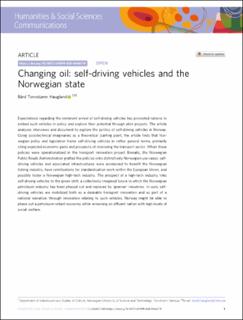| dc.contributor.author | Haugland, Bård Torvetjønn | |
| dc.date.accessioned | 2021-02-08T09:39:32Z | |
| dc.date.available | 2021-02-08T09:39:32Z | |
| dc.date.created | 2020-12-16T09:31:19Z | |
| dc.date.issued | 2020 | |
| dc.identifier.issn | 2662-9992 | |
| dc.identifier.uri | https://hdl.handle.net/11250/2726558 | |
| dc.description.abstract | Expectations regarding the imminent arrival of self-driving vehicles has prompted nations to embed such vehicles in policy and explore their potential through pilot projects. The article analyses interviews and document to explore the politics of self-driving vehicles in Norway. Using sociotechnical imaginaries as a theoretical starting point, the article finds that Norwegian policy and legislation frame self-driving vehicles in rather general terms, primarily citing expected economic gains and prospects of improving the transport sector. When these policies were operationalized in the transport innovation project Borealis, the Norwegian Public Roads Administration grafted the policies onto distinctively Norwegian use-cases: self-driving vehicles and associated infrastructures were envisioned to benefit the Norwegian fishing industry, have ramifications for standardization work within the European Union, and possibly foster a Norwegian high-tech industry. The prospect of a high-tech industry links self-driving vehicles to the green shift, a collectively imagined future in which the Norwegian petroleum industry has been phased out and replaced by ‘greener’ industries. In sum, self-driving vehicles are mobilized both as a desirable transport innovation and as part of a national narrative: through innovation relating to such vehicles, Norway might be able to phase out a petroleum-reliant economy while remaining an affluent nation with high levels of social welfare. | en_US |
| dc.language.iso | eng | en_US |
| dc.publisher | Springer Nature | en_US |
| dc.rights | Navngivelse 4.0 Internasjonal | * |
| dc.rights.uri | http://creativecommons.org/licenses/by/4.0/deed.no | * |
| dc.title | Changing oil: self-driving vehicles and the Norwegian state | en_US |
| dc.type | Peer reviewed | en_US |
| dc.type | Journal article | en_US |
| dc.description.version | publishedVersion | en_US |
| dc.source.journal | Humanities & Social Sciences Communications | en_US |
| dc.identifier.doi | 10.1057/s41599-020-00667-9 | |
| dc.identifier.cristin | 1860338 | |
| dc.relation.project | Norges forskningsråd: 283354 | en_US |
| dc.description.localcode | Open Access This article is licensed under a Creative Commons Attribution 4.0 International License, which permits use, sharing, adaptation, distribution and reproduction in any medium or format, as long as you give appropriate credit to the original author(s) and the source, provide a link to the Creative Commons license, and indicate if changes were made. The images or other third party material in this article are included in the article’s Creative Commons license, unless indicated otherwise in a credit line to the material. If material is not included in the article’s Creative Commons license and your intended use is not permitted by statutory regulation or exceeds the permitted use, you will need to obtain permission directly from the copyright holder. To view a copy of this license, visit http://creativecommons.org/licenses/by/4.0/. | en_US |
| cristin.ispublished | true | |
| cristin.fulltext | original | |
| cristin.qualitycode | 1 | |

